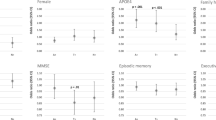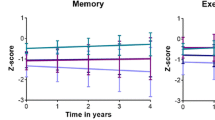Abstract
Background
Alzheimer’s disease (AD) and vascular cognitive impairment (VCI) are the two main causes of dementia. AD and VCI share similar symptoms of cognitive decline and may be attributable to similar risk factors. Establishing a prospective cohort to compare VCI and AD would help to understand vascular risk factors related to dementia.
Objectives
China Alzheimer’s disease and Neurodegenerative Disorder Research (CANDOR) study is a prospective multicenter cohort study. It aims to study the similarities and differences between AD and post stroke cognitive impairment (PSCI) in neuroimaging changes, disease progression, and multiple omics studies.
Design
This is an ongoing study. From July 31, 2019, to August 1, 2022, we recruited 1449 participants with ages between 40 and 100 years. The cohort included three groups: AD group, PSCI group, and normal cognitive (NC) group. Data were collected in face-to-face interviews at baseline, and will be followed up every year for 4 years. The PSCI group had additional follow-ups at 3-month and 6-month after enrollment. Brain Magnetic Resonance Imaging (MRI) included high-resolution sequences for intracranial arteries. Cognitive assessments and follow-up information will be prospectively collected. Biological specimens including blood and urine at baseline were collected and tested.
Participants
The targeted sample size of PSCI group was 500, AD group with 600 and NC group with 2000. There were 1449 participants enrolled. Include 508 participants were in NC group, 387 in AD group and 554 in PSCI group.
Measurements
Demographics, clinical parameters, and medical examinations were collected and performed. Cognitive assessment was performed to assess all cognitive domains including memory, language, executive function, and orientation function.
Conclusions
The CANDOR study is a prospective cohort study. Data from this cohort provide us an opportunity to investigate the contribution of vascular factors to dementia pathogenesis.
Similar content being viewed by others
Availability of data and materials
SL and JS had full access to all the data in the study and takes responsibility for the integrity of the data and the accuracy of the data analysis.
References
Jia L, Quan M, Fu Y, et al. Dementia in China: epidemiology, clinical management, and research advances. Lancet Neurol 2020; 19(1): 81–92. https://doi.org/10.1016/S1474-4422(19)30290-X
Prince MJ, Wu F, Guo Y, et al. The burden of disease in older people and implications for health policy and practice. Lancet 2015; 385(9967): 549–62. https://doi.org/10.1016/S0140-6736(14)61347-7
Iadecola C, Duering M, Hachinski V, et al. Vascular Cognitive Impairment and Dementia: JACC Scientific Expert Panel. J Am Coll Cardiol 2019; 73(25): 3326–44. https://doi.org/10.1016/j.jacc.2019.04.034
Ganguli M, Blacker D, Blazer DG, et al. Classification of neurocognitive disorders in DSM-5: a work in progress. The American journal of geriatric psychiatry: official journal of the American Association for Geriatric Psychiatry 2011; 19(3): 205–10. https://doi.org/10.1097/jgp.0b013e3182051ab4
Sachdev PS, Blacker D, Blazer DG, et al. Classifying neurocognitive disorders: the DSM-5 approach. Nature reviews Neurology 2014; 10(11): 634–42. https://doi.org/10.1038/nrneurol.2014.181
Mijajlovic MD, Pavlovic A, Brainin M, et al. Post-stroke dementia - a comprehensive review. BMC Med 2017; 15(1): 11. https://doi.org/10.1186/s12916-017-0779-7
Fernando MS, Ince PG, Function MRCC, et al. Vascular pathologies and cognition in a population-based cohort of elderly people. J Neurol Sci 2004; 226(1–2): 13–7. https://doi.org/10.1016/j.jns.2004.09.004
Rost NS, Brodtmann A, Pase MP, et al. Post-Stroke Cognitive Impairment and Dementia. Circ Res 2022; 130(8): 1252–71. https://doi.org/10.1161/CIRCRESAHA.122.319951
Huang YY, Chen SD, Leng XY, et al. Post-Stroke Cognitive Impairment: Epidemiology, Risk Factors, and Management. Journal of Alzheimer’s disease: JAD 2022; 86(3): 983–99. https://doi.org/10.3233/JAD-215644
Sexton E, McLoughlin A, Williams DJ, et al. Systematic review and meta-analysis of the prevalence of cognitive impairment no dementia in the first year post-stroke. Eur Stroke J 2019; 4(2): 160–71. https://doi.org/10.1177/2396987318825484
Sachdev PS, Lo JW, Crawford JD, et al. STROKOG (stroke and cognition consortium): An international consortium to examine the epidemiology, diagnosis, and treatment of neurocognitive disorders in relation to cerebrovascular disease. Alzheimers Dement (Amst) 2017; 7: 11–23. https://doi.org/10.1016/j.dadm.2016.10.006
Rost NS, Meschia JF, Gottesman R, et al. Cognitive Impairment and Dementia After Stroke: Design and Rationale for the DISCOVERY Study. Stroke 2021; 52(8): e499–e516. https://doi.org/10.1161/strokeaha.120.031611
McKhann G, Drachman D, Folstein M, et al. Clinical diagnosis of Alzheimer’s disease: report of the NINCDS-ADRDA Work Group under the auspices of Department of Health and Human Services Task Force on Alzheimer’s Disease. Neurology 1984; 34(7): 939–44. https://doi.org/10.1212/wnl.34.7.939
Sperling RA, Aisen PS, Beckett LA, et al. Toward defining the preclinical stages of Alzheimer’s disease: recommendations from the National Institute on Aging-Alzheimer’s Association workgroups on diagnostic guidelines for Alzheimer’s disease. Alzheimers Dement 2011; 7(3): 280–92. https://doi.org/10.1016/j.jalz.2011.03.003
Stroke—1989. Recommendations on stroke prevention, diagnosis, and therapy. Report of the WHO Task Force on Stroke and other Cerebrovascular Disorders. Stroke 1989; 20(10): 1407–31. https://doi.org/10.1161/01.str.20.10.1407
Jorm AF, Jacomb PA. The Informant Questionnaire on Cognitive Decline in the Elderly (IQCODE): socio-demographic correlates, reliability, validity and some norms. Psychol Med 1989; 19(4): 1015–22. https://doi.org/10.1017/s0033291700005742
Arauz A, Rodríguez-Agudelo Y, Sosa AL, et al. Vascular cognitive disorders and depression after first-ever stroke: the Fogarty-Mexico Stroke Cohort. Cerebrovascular diseases (Basel, Switzerland) 2014; 38(4): 284–9. https://doi.org/10.1159/000366471
Whelton PK, Carey RM, Aronow WS, et al. 2017 ACC/AHA/AAPA/ABC/ACPM/AGS/APhA/ASH/ASPC/NMA/PCNA Guideline for the Prevention, Detection, Evaluation, and Management of High Blood Pressure in Adults: A Report of the American College of Cardiology/American Heart Association Task Force on Clinical Practice Guidelines. Hypertension 2018; 71(6): e13–e115. https://doi.org/10.1161/HYP.0000000000000065
American Diabetes A. 2. Classification and Diagnosis of Diabetes: Standards of Medical Care in Diabetes-2019. Diabetes Care 2019; 42(Suppl 1): S13–S28. https://doi.org/10.2337/dc19-S002
Klunk WE, Engler H, Nordberg A, et al. Imaging brain amyloid in Alzheimer’s disease with Pittsburgh Compound-B. Ann Neurol 2004; 55(3): 306–19. https://doi.org/10.1002/ana.20009
Gao F, Lv X, Dai L, et al. A combination model of AD biomarkers revealed by machine learning precisely predicts Alzheimer’s dementia: China Aging and Neurodegenerative Initiative (CANDI) study. Alzheimers Dement 2022. https://doi.org/10.1002/alz.12700
Zhang M, Yang L, Wang L, et al. Trends in smoking prevalence in urban and rural China, 2007 to 2018: Findings from 5 consecutive nationally representative cross-sectional surveys. PLoS Med 2022; 19(8): e1004064. https://doi.org/10.1371/journal.pmed.1004064
Zhang M, Wu J, Zhang X, et al. [Prevalence and control of hypertension in adults in China, 2018]. Zhonghua liu xing bing xue za zhi = Zhonghua liuxingbingxue zazhi 2021; 42(10): 1780–9. https://doi.org/10.3760/cma.j.cn112338-20210508-00379
Li Y, Teng D, Shi X, et al. Prevalence of diabetes recorded in mainland China using 2018 diagnostic criteria from the American Diabetes Association: national cross sectional study. BMJ 2020; 369: m997. https://doi.org/10.1136/bmj.m997
Weiner MW, Veitch DP, Aisen PS, et al. Impact of the Alzheimer’s Disease Neuroimaging Initiative, 2004 to 2014. Alzheimers Dement 2015; 11(7): 865–84. https://doi.org/10.1016/j.jalz.2015.04.005
Iwatsubo T, Iwata A, Suzuki K, et al. Japanese and North American Alzheimer’s Disease Neuroimaging Initiative studies: Harmonization for international trials. Alzheimers Dement 2018; 14(8): 1077–87. https://doi.org/10.1016/j.jalz.2018.03.009
Pendlebury ST, Poole D, Burgess A, et al. APOE-epsilon4 Genotype and Dementia Before and After Transient Ischemic Attack and Stroke: Population-Based Cohort Study. Stroke 2020; 51(3): 751–8. https://doi.org/10.1161/STROKEAHA.119.026927
Howard VJ, Cushman M, Pulley L, et al. The reasons for geographic and racial differences in stroke study: objectives and design. Neuroepidemiology 2005; 25(3): 135–43. https://doi.org/10.1159/000086678
Weaver NA, Kuijf HJ, Aben HP, et al. Strategic infarct locations for post-stroke cognitive impairment: a pooled analysis of individual patient data from 12 acute ischaemic stroke cohorts. Lancet Neurol 2021; 20(6): 448–59. https://doi.org/10.1016/S1474-4422(21)00060-0
Veitch DP, Weiner MW, Aisen PS, et al. Understanding disease progression and improving Alzheimer’s disease clinical trials: Recent highlights from the Alzheimer’s Disease Neuroimaging Initiative. Alzheimers Dement 2019; 15(1): 106–52. https://doi.org/10.1016/j.jalz.2018.08.005
Saykin AJ, Shen L, Yao X, et al. Genetic studies of quantitative MCI and AD phenotypes in ADNI: Progress, opportunities, and plans. Alzheimers Dement 2015; 11(7): 792–814. https://doi.org/10.1016/j.jalz.2015.05.009
Levine DA, Wadley VG, Langa KM, et al. Risk Factors for Poststroke Cognitive Decline: The REGARDS Study (Reasons for Geographic and Racial Differences in Stroke). Stroke 2018; 49(4): 987–94. https://doi.org/10.1161/STROKEAHA.117.018529
Smith EE, Duchesne S, Gao F, et al. Vascular Contributions to Neurodegeneration: Protocol of the COMPASS-ND Study. Can J Neurol Sci 2021; 48(6): 799–806. https://doi.org/10.1017/cjn.2021.19
Kivipelto M, Mangialasche F, Snyder HM, et al. World-Wide FINGERS Network: A global approach to risk reduction and prevention of dementia. Alzheimers Dement 2020; 16(7): 1078–94. https://doi.org/10.1002/alz.12123
Norton S, Matthews FE, Barnes DE, et al. Potential for primary prevention of Alzheimer’s disease: an analysis of population-based data. Lancet Neurol 2014; 13(8): 788–94. https://doi.org/10.1016/S1474-4422(14)70136-X
Nguyen DH, Cunningham JT, Sumien N. Estrogen receptor involvement in vascular cognitive impairment and vascular dementia pathogenesis and treatment. Geroscience 2021; 43(1): 159–66. https://doi.org/10.1007/s11357-020-00263-4
Javanshiri K, Waldö ML, Friberg N, et al. Atherosclerosis, Hypertension, and Diabetes in Alzheimer’s Disease, Vascular dementia, and Mixed Dementia: Prevalence and Presentation. J Alzheimers Dis 2018; 66(4): 1753. https://doi.org/10.3233/jad-189011
Bai R, Li Z, Sun C, et al. Feasibility of filter-exchange imaging (FEXI) in measuring different exchange processes in human brain. Neuroimage 2020; 219: 117039. https://doi.org/10.1016/j.neuroimage.2020.117039
Acknowledgement
We would like to thank the participants and their caregivers who participated in the study.
Funding
Supported by Strategic Priority Research Program of the Chinese Academy of Sciences (XDB39000000) and Beijing Municipal Science & Technology Commission (Grant No. Z181100001518005).
Author information
Authors and Affiliations
Contributions
SL and JS designed the study. HD, YW, SW, XL, MD, ST collected data. SL, HD, YW and JS analyzed data. YW and SL created the tables. SL, YW and JS did the scientific literature search. SL, HD, YW, and JS wrote and all authors edited the report. All authors read and approve the manuscript.
Corresponding author
Ethics declarations
Declarations: Ethics approval and consent to participate: Institutional Review Board of Beijing Tiantan Hospital approved the protocol (approval number: KY 2019-004-007). We obtained written informed consent from each participant.
Competing interests: None.
Additional information
Trail registration number
NCT04320368.
Rights and permissions
About this article
Cite this article
Li, S., Dong, H., Wang, Y. et al. China Alzheimer’s Disease and Neurodegenerative Disorder Research (CANDOR) -A Prospective Cohort Study for Alzheimer’s Disease and Vascular Cognitive Impairment. J Prev Alzheimers Dis 11, 214–221 (2024). https://doi.org/10.14283/jpad.2023.97
Received:
Accepted:
Published:
Issue Date:
DOI: https://doi.org/10.14283/jpad.2023.97




